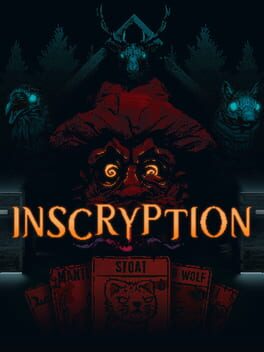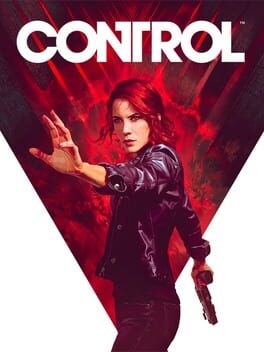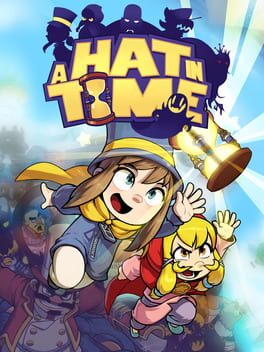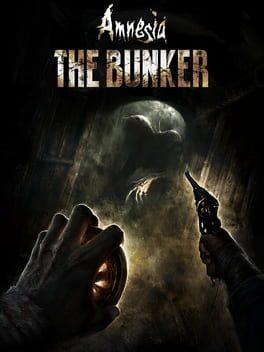106 Reviews liked by aquelejoel
Death Stranding
2019
a weird game to recommend, I could talk for hours about the things I like about it, but honestly, just try it out, be patient with it and it may reward you with a playthrough that sticks with you for years. The story might not be the best, or its combat super engaging, but it is a game that absorbs you in it's world. Whatever you put in, how you involve yourself, the game gives back in spades.
Inscryption
2021
Jogaço da porra, só falta jogar o Kaycee's Mod mas acho que não vou zerar ele pq to com outras coisas pra jogar, apesar de eu ter já visto a série do Markiplier no yt esse jogo ainda me divertiu bastante e segredos que não fazia idéia que existiam.
Enfim, apenas jogue este jogo, vale super a pena e o mais importante, jogue sem saber de nada.
Enfim, apenas jogue este jogo, vale super a pena e o mais importante, jogue sem saber de nada.
Geralmente não gosto de dar notas máximas em coisas que avalio, mas Zelda BOTW é um jogo que desde o lançamento me chamou atenção e, mesmo só conseguindo jogá-lo muito tempo depois, os sentimentos de aventura, solidão, desafio e vários outros ainda foram passados de maneira extraordinária.
Fiquei preso nesse jogo durante muito tempo enquanto estava zerando e provavelmente vai ser um jogo que irei revisitar mais vezes.
Fiquei preso nesse jogo durante muito tempo enquanto estava zerando e provavelmente vai ser um jogo que irei revisitar mais vezes.
Go Go Ackman
1994
Acidentalmente, acabamos fazendo um especial sem realmente ser algo próximo disto por pura sacanagem e Akira Toriyama acabou sendo o palco deste início de mês. Mesmo que eu já tenha finalizado algo que ele trabalhou há pouco tempo: Chrono Trigger; chegou a vez de concluir outra obra dele e neste caso, para mim e para muitos era parte de um backlog passado ou até mesmo a introdução dele: Go Go Ackman! para Super Famicom.
A empresa responsável pelo jogo chama-se Banpresto e pelo que já andei jogando na minha vida como um todo, grande parte dos jogos desta empresa e até mesmo coisas Bandai, costumam ter um estilo único para o Super Nintendo e tudo acaba ficando muito próximo do esperado e por se tratar de Akira Toriyama, não poderia ser diferente. Tudo exala Akira, não tem como... aqui vimos Dragon Ball à qualquer custo. Muito bem feito.
Enquanto o gráfico exala Akira, o som exala Super Famicom na sua mais pura essência. Tudo e quaisquer música ou sfx deste jogo tem cheiro ocidental na sua forma mais nobre, sem exagerar tanto do grave e mantendo sua melodia do início ao fim. Pode ser que haja um loop aqui ou ali, mas nada que atrapalhe ou irrite, pois é um jogo perfeitinho até nisto.
Já em questão de dificuldade o jogo deixa a desejar porque é realmente muito fácil. Não há muito o que se dizer em relação ao seu esforço em manter o jogador ali porque não existe empenho nenhum dos DEVs em querer te prender ao jogo. É um puro plataforma onde você apenas anda e pula, porém o erro não é tão justificativo visto que o jogo possui continue extra.
Mesmo que a dificuldade seja seu ponto fraco, o jogo te diverte de várias maneiras: chutar a cara de alguns inimigos é bem engraçado. Seus pulos de fé também são divertidos, visto que o jogo quer te assustar, mas quando tu ver, tem algo lá embaixo e que às vezes pode ser raro ou te ajuda na jogatina. O 3oitão é melhor arma do jogo!
Este é o típico jogo que você pega para finalizar no fim de semana tomando um cerveja. Sem preocupação, sem muito o que fazer... apenas anda para frente, dar uns pulos de fé e socar até mulher. Jogão!
A empresa responsável pelo jogo chama-se Banpresto e pelo que já andei jogando na minha vida como um todo, grande parte dos jogos desta empresa e até mesmo coisas Bandai, costumam ter um estilo único para o Super Nintendo e tudo acaba ficando muito próximo do esperado e por se tratar de Akira Toriyama, não poderia ser diferente. Tudo exala Akira, não tem como... aqui vimos Dragon Ball à qualquer custo. Muito bem feito.
Enquanto o gráfico exala Akira, o som exala Super Famicom na sua mais pura essência. Tudo e quaisquer música ou sfx deste jogo tem cheiro ocidental na sua forma mais nobre, sem exagerar tanto do grave e mantendo sua melodia do início ao fim. Pode ser que haja um loop aqui ou ali, mas nada que atrapalhe ou irrite, pois é um jogo perfeitinho até nisto.
Já em questão de dificuldade o jogo deixa a desejar porque é realmente muito fácil. Não há muito o que se dizer em relação ao seu esforço em manter o jogador ali porque não existe empenho nenhum dos DEVs em querer te prender ao jogo. É um puro plataforma onde você apenas anda e pula, porém o erro não é tão justificativo visto que o jogo possui continue extra.
Mesmo que a dificuldade seja seu ponto fraco, o jogo te diverte de várias maneiras: chutar a cara de alguns inimigos é bem engraçado. Seus pulos de fé também são divertidos, visto que o jogo quer te assustar, mas quando tu ver, tem algo lá embaixo e que às vezes pode ser raro ou te ajuda na jogatina. O 3oitão é melhor arma do jogo!
Este é o típico jogo que você pega para finalizar no fim de semana tomando um cerveja. Sem preocupação, sem muito o que fazer... apenas anda para frente, dar uns pulos de fé e socar até mulher. Jogão!
Alan Wake II
2023
Control
2019
Eu sinto pena de Control ser um jogo e não poder ser chamado de surrealista.
Antes que esse comentário soe como pedante ou diminutivo para jogos como arte ou Control como um jogo, preciso deixar claro o que senti enquanto jogava Control.
Eu já havia deixado de jogar Control antes, mas por estar testando e não ter ido muito a fundo no que se tratava. Depois de ter jogado Alan Wake, jogar Control era o próximo passo lógico e estava emocionalmente preparado para o que quer que fosse esse jogo.
Control é bem estranho, de fato.
Visualmente, é um espetáculo, o surrealismo aqui se mistura ao brutalismo e nos deixa insignificantes e ao mesmo tempo, inconsequentes. Isso, apoiado em uma narrativa bem única, promove um jogo AAA pelo menos “estranho” e nisso Control me fisgou em vários momentos. É uma pena, porém, esse jogo encontrar amarras justamente no que o torna um jogo.
Inicialmente, as mecânicas de Control são: jogo de ação com poderes. Os poderes não são nada de mais e a maior conexão que consigo tirar é que, de fato, estamos TOMANDO CONTROLE.
Os poderes nos fazem tomar controle de objetos, pessoas e até de nós mesmos ao levitarmos e manipularmos nosso corpo. Porém, essa conexão é uma linha fina e sensível que acaba se estourando ao ser estressada pelo loop encharcado de combate. Eventualmente, o ato de controlar, que inicialmente parece tão significativo quanto a lanterna do Alan Wake, se torna apenas mais uma mecânica de combate junto às diversas armas, upgrades e mods que você encontra pelo jogo.
O momento em que Control foi mais livre é o labirinto vivo do TAKE CONTROL. Ali o jogo consegue ser livre em estética e arte, mas também em mecânica, ainda mais se, assim como eu, você balanceou o jogo para ter energia quase infinita e poder flutuar e usar poderes à vontade. Se eu não tivesse feito isso, talvez não teria terminado esse jogo, mas, graças a uma feature modular de dificuldade, consegui ter uma experiência boa, mas que beirou o cansaço e exaustão de combate, ainda mais quando se trata da FUNDAÇÃO, a DLC que é, basicamente, combate e puzzles.
Puzzles aqui que não usam 100% do que poderíamos fazer com a simples mecânica de telecinese. Em Alan Wake, por exemplo, a Remedy extrapola mais o significado de luz e temos equipamentos e puzzles que utilizam a luz, alguns até de forma inteligente. Aqui, os puzzles são simples e parece que a mecânica de telecinese se resume a encaixar objeto A no ponto B, coisa que poderíamos fazer com as mãos.
Porém, se formos olhar em uma perspectiva de design, Control é amarradinho no que se espera de um jogo, e é nesse ponto que eu não gosto da conceitualização de Control como “video games”. Do mesmo jeito que criticamos a implementação de mundos abertos sem um porquê, sidequests, níveis e loot sem um porquê em jogos AAA do mercado, me pergunto o mesmo para Control que, surpreendentemente, inclui cada um desses aspectos citados. Agora, por que? Não consegui encontrar essa resposta no jogo, mas em mim, isso apenas me desconectou da experiência como faria em qualquer jogo da Ubisoft.
Na verdade, essa falta de conexão na minha experiência ficou também na narrativa. Apesar de adorar sua direção, os temas são, basicamente, Worldbuilding. A trama pessoal da Jesse aqui não importou muito para mim já que o jogo parecia se importar mais em explicar e estender as regras daquele universo.
Existe uma questão sobre explicar universos fictícios que me intriga em alguns jogos, o apego pelas regras. As regras do mundo são cruciais para a elaboração de um worldbuilding, é isso que aprendemos em cursos de narrative design, mas quando vejo um jogo que se preocupa tanto com regras e “porquês” eu sinto um realismo que não me agrada muito em jogos que querem ser tão livres quanto Control. Ao meu ver, esses jogos brilham quando justamente o Porquê não está em um item de lore, um codex ou uma teoria do personagem, mas sim em nossa interpretação.
Por que a Jesse é a Diretora? Porque o jogo é sobre controle, e para mim, isso é suficiente.
Mas, novamente, isso é esperado de grandes jogos. Mesmo sabendo que jogos são tão jogos com ou sem combate, upgrades, mundo aberto e um worldbuilding coeso, Control parece se render, o que é uma pena. Afinal, não diria que Control é surreal, já que absolutamente tudo naquele jogo está imerso e ancorado na sua própria realidade e, sendo as suas regras claras, as consequências são previsíveis e pouco subjetivas, mas pelo menos divertidas.
Antes que esse comentário soe como pedante ou diminutivo para jogos como arte ou Control como um jogo, preciso deixar claro o que senti enquanto jogava Control.
Eu já havia deixado de jogar Control antes, mas por estar testando e não ter ido muito a fundo no que se tratava. Depois de ter jogado Alan Wake, jogar Control era o próximo passo lógico e estava emocionalmente preparado para o que quer que fosse esse jogo.
Control é bem estranho, de fato.
Visualmente, é um espetáculo, o surrealismo aqui se mistura ao brutalismo e nos deixa insignificantes e ao mesmo tempo, inconsequentes. Isso, apoiado em uma narrativa bem única, promove um jogo AAA pelo menos “estranho” e nisso Control me fisgou em vários momentos. É uma pena, porém, esse jogo encontrar amarras justamente no que o torna um jogo.
Inicialmente, as mecânicas de Control são: jogo de ação com poderes. Os poderes não são nada de mais e a maior conexão que consigo tirar é que, de fato, estamos TOMANDO CONTROLE.
Os poderes nos fazem tomar controle de objetos, pessoas e até de nós mesmos ao levitarmos e manipularmos nosso corpo. Porém, essa conexão é uma linha fina e sensível que acaba se estourando ao ser estressada pelo loop encharcado de combate. Eventualmente, o ato de controlar, que inicialmente parece tão significativo quanto a lanterna do Alan Wake, se torna apenas mais uma mecânica de combate junto às diversas armas, upgrades e mods que você encontra pelo jogo.
O momento em que Control foi mais livre é o labirinto vivo do TAKE CONTROL. Ali o jogo consegue ser livre em estética e arte, mas também em mecânica, ainda mais se, assim como eu, você balanceou o jogo para ter energia quase infinita e poder flutuar e usar poderes à vontade. Se eu não tivesse feito isso, talvez não teria terminado esse jogo, mas, graças a uma feature modular de dificuldade, consegui ter uma experiência boa, mas que beirou o cansaço e exaustão de combate, ainda mais quando se trata da FUNDAÇÃO, a DLC que é, basicamente, combate e puzzles.
Puzzles aqui que não usam 100% do que poderíamos fazer com a simples mecânica de telecinese. Em Alan Wake, por exemplo, a Remedy extrapola mais o significado de luz e temos equipamentos e puzzles que utilizam a luz, alguns até de forma inteligente. Aqui, os puzzles são simples e parece que a mecânica de telecinese se resume a encaixar objeto A no ponto B, coisa que poderíamos fazer com as mãos.
Porém, se formos olhar em uma perspectiva de design, Control é amarradinho no que se espera de um jogo, e é nesse ponto que eu não gosto da conceitualização de Control como “video games”. Do mesmo jeito que criticamos a implementação de mundos abertos sem um porquê, sidequests, níveis e loot sem um porquê em jogos AAA do mercado, me pergunto o mesmo para Control que, surpreendentemente, inclui cada um desses aspectos citados. Agora, por que? Não consegui encontrar essa resposta no jogo, mas em mim, isso apenas me desconectou da experiência como faria em qualquer jogo da Ubisoft.
Na verdade, essa falta de conexão na minha experiência ficou também na narrativa. Apesar de adorar sua direção, os temas são, basicamente, Worldbuilding. A trama pessoal da Jesse aqui não importou muito para mim já que o jogo parecia se importar mais em explicar e estender as regras daquele universo.
Existe uma questão sobre explicar universos fictícios que me intriga em alguns jogos, o apego pelas regras. As regras do mundo são cruciais para a elaboração de um worldbuilding, é isso que aprendemos em cursos de narrative design, mas quando vejo um jogo que se preocupa tanto com regras e “porquês” eu sinto um realismo que não me agrada muito em jogos que querem ser tão livres quanto Control. Ao meu ver, esses jogos brilham quando justamente o Porquê não está em um item de lore, um codex ou uma teoria do personagem, mas sim em nossa interpretação.
Por que a Jesse é a Diretora? Porque o jogo é sobre controle, e para mim, isso é suficiente.
Mas, novamente, isso é esperado de grandes jogos. Mesmo sabendo que jogos são tão jogos com ou sem combate, upgrades, mundo aberto e um worldbuilding coeso, Control parece se render, o que é uma pena. Afinal, não diria que Control é surreal, já que absolutamente tudo naquele jogo está imerso e ancorado na sua própria realidade e, sendo as suas regras claras, as consequências são previsíveis e pouco subjetivas, mas pelo menos divertidas.
A Hat in Time
2017
Veredito: Mais um coletaton delícia.
A Hat in Time é mais um daqueles jogos super maneiros que não são MEU DEUS DO CÉU QUE PUTA OBRA FODONA, VENHA COMER MEU CU mas tudo bem, não precisa ser. Ele é só um jogo bastante delicinha e feito com muito carinho. E isso basta.
É bem óbvia a inspiração nos coletatons do N64, Cube, PS1 e PS2: um plataforma de explorar a fase e caçar colecionáveis. Os mundos são coloridos, a exploração é recompensadora, as habilidades fluem bem e são bem utilizadas nas fases e nas missões (muito gostoso correr na parede e mergulhar no meio do pulo), e os personagens são bastante caricatos, hilários e expressivos. Não é perfeito, mas de novo: tudo bem, não precisa ser.
Já vi gente reclamando da curta duração. Pra mim ele tem o tempo exato que é pra ter: o tempo de explorar todas as mecânicas e ser gostoso do começo ao fim. Ele poderia ser maior? Poderia. Mas se for pra esticar artificialmente um jogo, com gordura mal feita só pra dizer que é longo... Deixa o jogo ser curto mesmo. Fica mais rejogável assim.
Aliás, parabéns pra Gears for Breakfast pelo EXCELENTE suporte a mods. Nada de ficar instalando eles no braço lá da oficina da Steam, ou pior: baixando de um Nexus da vida e procurando online guias complicados de instalação. Você entra na sala do hub dedicada a isso, fala com o personagem de lá e pronto: é só escolher o mod que você quer jogar.
Dito e feito: depois de zerar, perdi várias horas me divertindo com o que a comunidade já criou. Joguei dois time rifts, uma fase super caprichadíssima baseada em Celeste, e um projeto ambicioso que por enquanto só tem a 1ª fase com uma área secreta. E isso não foi praticamente nada, é só a ponta do iceberg, se eu quisesse tava jogando mod até agora e ainda por muitos dias a fio.
E pessoal ainda vem reclamar que o jogo devia ter mais conteúdo?
A Hat in Time é mais um daqueles jogos super maneiros que não são MEU DEUS DO CÉU QUE PUTA OBRA FODONA, VENHA COMER MEU CU mas tudo bem, não precisa ser. Ele é só um jogo bastante delicinha e feito com muito carinho. E isso basta.
É bem óbvia a inspiração nos coletatons do N64, Cube, PS1 e PS2: um plataforma de explorar a fase e caçar colecionáveis. Os mundos são coloridos, a exploração é recompensadora, as habilidades fluem bem e são bem utilizadas nas fases e nas missões (muito gostoso correr na parede e mergulhar no meio do pulo), e os personagens são bastante caricatos, hilários e expressivos. Não é perfeito, mas de novo: tudo bem, não precisa ser.
Já vi gente reclamando da curta duração. Pra mim ele tem o tempo exato que é pra ter: o tempo de explorar todas as mecânicas e ser gostoso do começo ao fim. Ele poderia ser maior? Poderia. Mas se for pra esticar artificialmente um jogo, com gordura mal feita só pra dizer que é longo... Deixa o jogo ser curto mesmo. Fica mais rejogável assim.
Aliás, parabéns pra Gears for Breakfast pelo EXCELENTE suporte a mods. Nada de ficar instalando eles no braço lá da oficina da Steam, ou pior: baixando de um Nexus da vida e procurando online guias complicados de instalação. Você entra na sala do hub dedicada a isso, fala com o personagem de lá e pronto: é só escolher o mod que você quer jogar.
Dito e feito: depois de zerar, perdi várias horas me divertindo com o que a comunidade já criou. Joguei dois time rifts, uma fase super caprichadíssima baseada em Celeste, e um projeto ambicioso que por enquanto só tem a 1ª fase com uma área secreta. E isso não foi praticamente nada, é só a ponta do iceberg, se eu quisesse tava jogando mod até agora e ainda por muitos dias a fio.
E pessoal ainda vem reclamar que o jogo devia ter mais conteúdo?
Amnesia: The Bunker
2023
Deixei este jogo na prateleira por um bom tempo pois para mim sua dificuldade (ou a minha burrice) estavam me impedindo de progreduir e acabei droppando por um tempo, agora que cheguei na cutscene final e terminei o jogo, só percebi que eu era burro e que não tinha pensado nas ações que iria tomar durante a jogatina.
Amnesia: The Bunker foi uma experiência apavorosa nas primeiras vezes que joguei e ainda continuou um pouco pois não sabia do próximo movimento da criatura, o som ambiente e a preocupação de não fazer nenhum misero barulho faz com que todaessa experiência fique mais tensa, as vezes acontecia a mesma coisa com as pessoas jogando Darkwood nas primeiras horas.
Durante a gameplay, a cautela é a prioridade. Cuidado com os sons de seus passos, da sua lanterna recarregável e das coisas que caem no chão, tudo aqui pode ser sempre um motivo para alertar a atenção do monstro, e ele é imortal, gastar balas, coquetéis molotovs e granadas vão fazer o monstro se tremer de medo e ir embora por um tempo, tempo bom o bastante para cumprir com seus objetivos (pelo menos na dificuldade que joguei)
Enfim, este jogo é incrível, tive esta vontade de jogar alguma coisa de terror depois do video do RyanRed de DarkWood e acabei lembrando desse camarada aqui que precisava ser zerado, recomendo demais!!
Amnesia: The Bunker foi uma experiência apavorosa nas primeiras vezes que joguei e ainda continuou um pouco pois não sabia do próximo movimento da criatura, o som ambiente e a preocupação de não fazer nenhum misero barulho faz com que todaessa experiência fique mais tensa, as vezes acontecia a mesma coisa com as pessoas jogando Darkwood nas primeiras horas.
Durante a gameplay, a cautela é a prioridade. Cuidado com os sons de seus passos, da sua lanterna recarregável e das coisas que caem no chão, tudo aqui pode ser sempre um motivo para alertar a atenção do monstro, e ele é imortal, gastar balas, coquetéis molotovs e granadas vão fazer o monstro se tremer de medo e ir embora por um tempo, tempo bom o bastante para cumprir com seus objetivos (pelo menos na dificuldade que joguei)
Enfim, este jogo é incrível, tive esta vontade de jogar alguma coisa de terror depois do video do RyanRed de DarkWood e acabei lembrando desse camarada aqui que precisava ser zerado, recomendo demais!!
Hades
2020
Hades é uma obra-prima atemporal, inacreditável ter sido feito por um estúdio "indie".
A trilha sonora do jogo é surreal, excelente, sensacional, tanto nas partes de ação quanto nas partes de diálogo. Ela reflete o que está acontecendo no jogo muito bem.
Os diálogos então... coisa de outro mundo. Cada vez que você fala com um personagem após morrer, é uma interação diferente que vai mudando após cada vez, sempre adicionando um extra à história.
Sua Gameplay é um tipo de fusão entre "Hack N Slash" e "Roguelike", você sai descendo a porrada em ondas de inimigos, cada vez com combinações diferentes de poderes à sua escolha, com bosses que variam a cada run/morte, e que estão sempre mudando/evoluindo.
Pra completar o final verdadeiro é necessário passar pelo final boss dez vezes, o que pode ser uma dor no cool, mas que acaba passando rápido devido a diversão que o jogo proporciona.
A história do jogo é fenomenal, montada por uma série de diálogos ricos distribuídos pelo jogo.
Seus gráficos são uma belíssima mescla de 2D com 3D.
Em suma: um diamante bruto.
Tempo de jogo: 25 horas
A trilha sonora do jogo é surreal, excelente, sensacional, tanto nas partes de ação quanto nas partes de diálogo. Ela reflete o que está acontecendo no jogo muito bem.
Os diálogos então... coisa de outro mundo. Cada vez que você fala com um personagem após morrer, é uma interação diferente que vai mudando após cada vez, sempre adicionando um extra à história.
Sua Gameplay é um tipo de fusão entre "Hack N Slash" e "Roguelike", você sai descendo a porrada em ondas de inimigos, cada vez com combinações diferentes de poderes à sua escolha, com bosses que variam a cada run/morte, e que estão sempre mudando/evoluindo.
Pra completar o final verdadeiro é necessário passar pelo final boss dez vezes, o que pode ser uma dor no cool, mas que acaba passando rápido devido a diversão que o jogo proporciona.
A história do jogo é fenomenal, montada por uma série de diálogos ricos distribuídos pelo jogo.
Seus gráficos são uma belíssima mescla de 2D com 3D.
Em suma: um diamante bruto.
Tempo de jogo: 25 horas
Pentiment
2022
‘This was the only earthly love of my life, and I could not, then or ever after, call that love by name.’
– Umberto Eco, Il nome della rosa, 1980.
Capturing the contours of a sixteenth-century society in the Holy Roman Empire is a difficult task. Central Europe was undergoing complex transitions as a result of demographic recovery, religious innovation and the administrative mosaic of Germanic territories. Recent historiography emphasises the interlocking and overlapping of forces that shaped regions and societies: it is difficult to generalise local observations to the rest of the Empire, but it is also unwise to paint the portrait of a village on the basis of generalities alone. For example, the forms of feudalism differed on either side of the Elbe. A theoretical simplification is to consider the regions south and west of the Elbe as being under the rule of Grundherrschaft [1]. This form of feudalism developed from the 14th century onwards with the decline of the traditional smaller lords and the demographic collapse caused by the Black Death. This situation allowed the surviving peasants to expand their farms and establish stronger hereditary rights over the land. Although still subject to the authority of their local lord, they had greater freedom of action.
History, fiction and myth: the Umbertian gaze
Towards the end of the fifteenth century, friction between the nobility and the peasantry increased as the former sought to assert their authority over land that seemed to have been de facto freed from serfdom. Another factor in the social crisis was undoubtedly the demographic upturn from 1470 onwards, which swelled the cohort of landless peasants, while small landowners were no longer able to take advantage of the economic opportunities of the previous century. In some southern regions of the Holy Roman Empire, agricultural production was no longer profitable, so it became mainly subsistence farming. These factors led to a widening gap between the peasants and the lords. The lords, sometimes nobility, sometimes clergy, were in latent conflict for other economic and political reasons.
It is difficult to summarise several thousand pages of social history in a few lines, so these few elements of context will suffice. Pentiment makes the bold choice of setting its action in this complex historical background, in a locality centred around the village of Tassing and Kiersau Abbey. The project explicitly borrows from Umberto Eco's The Name of the Rose (1980). Although the historical context is different, the themes and structure are similar. Eco's readers will find themselves in familiar territory: Pentiment allows the player to assume the role of Andreas Maler, a Nuremberg artist commissioned by the Abbot of Kiersau to illustrate a Book of Hours as part of his certification as a master artist. During his stay in Tassing, Andreas gets to know the many members of the local society, until a murder takes place. For personal reasons, Andreas is thrust into the role of detective and must unravel the many secrets of the community.
Like The Name of the Rose, Pentiment multiplies points of view and semantic layers. The game is at once a general dissertation on the social history of the Holy Roman Empire, a detective story, a philosophical debate, a theological meditation and a discussion on the value of storytelling. It is through this literary device, borrowed from Eco, that the title manages to find a great deal of coherence in its storytelling [2]. The investigation – i.e. the criminal story – is interwoven with the socio-political narrative, so that the player is constantly confronted with both general and specific elements. Andreas Maler acts as a bridge between these two worlds. Firstly, because he finds himself at the crossroads of very different social universes: as a traveller, he is used to many cultures; as a young artist, he associates with the powerful without being fully part of their universe. Above all, he is a stranger to Tassing, and his gaze is that of a witness whose interest in local politics, however altruistic, is rather weak. In other words, his view is certainly subjective, but it is all-encompassing. These characteristics are very similar to those of William of Baskerville, who had a complex theological background.
Depicting the Middle Ages through the new social studies
In terms of narrative economy, such a protagonist captures the player's attention in a number of ways. For classically trained historians, Andreas provides access to the ancient and medieval literary world; for mystery fans, his role as a detective is crucial. The choice of Andreas' background means that, in addition to the interactive gameplay typical of CRPGs, players can personalise their experience around the themes that interest them most. As a Latinist, I was pleasantly surprised to see Pentiment commanding a very solid Latin, and to read the classical locutions quoted by Andreas. The title has a rare encyclopaedic quality, in tune with recent scholarly developments. There remain a few very minor approximations, such as certain onomastic choices (Else Mülleryn should rather be spelt Müllerin) and Kiersau's remarkable and exagerated interregionalism. On the latter point, the choice was certainly motivated by Umberto Eco's vision of a universalist abbey and a political response to Kingdom Come: Delivrance (2018): the figure of the Ethiopian priest Sebhat seems a rather explicit foil to Daniel Vávra's ultra-conservative claims about the absence of people of colour in fifteenth-century Bohemia.
Pentiment always uses its encyclopaedic knowledge wisely to illustrate medieval mentalities. Arrogantly imparting knowledge is the best way to undermine the friendship and support of the game's various characters. The game constantly seeks to highlight the limits of Andreas' knowledge and the subjectivity of the concept of truth. As such, Pentiment seeks to portray the situation of women in the Middle Ages with real nuance. The game's fictional micro-history project features women who are involved in their village's economy and are pillars of the community. Discussions with the Benedictine nuns also provide an opportunity to explore women in religion, and Pentiment clearly illustrates the prejudices of the time, as well as Andreas' very masculine perspective. In contrast to the Christian tradition, which leaves no place for women in its traditional hierarchy – women's religious offices generally disappeared in the central Middle Ages, which is exactly the situation described for Kiersau Abbey – and restricts them to religious life or marriage, Pentiment constantly emphasises their agency and the ways in which they can circumvent the restrictions. Amalie illustrates the extreme spiritual experiences that women can voluntarily inflict on themselves through her retreat and mystical visions. Illuminata embodies a mastery of the literary classics, while the other sisters stand out for their practical knowledge and integration into Tassing society.
To write, to read and to die in the universal library
Like Umberto Eco's library, that of Kiersau Abbey is intended to be universal. It seeks to circumscribe all known knowledge through the possession of rare volumes, be they erudite treatises or chivalric romances. Writing and rewriting are at the heart of Pentiment's project. The narrative is subjective and subject to numerous corrections: when the dialogue is presented, mistakes punctuate the text and are corrected in front of the player. Similarly, the choice of script depends on the impression the speaker makes on Andreas. He presents the discourse of the educated clergy in a Gothic style, while the villagers have a much less polished script. Above all, it is noteworthy that Andreas changes his representation according to the information he receives. For example, when he learns that the shepherd is actually an avid reader of Latin books, he updates the script used in the dialogue. These elements are linked to a concern for memory, and Pentiment sets out to question what deserves to be left to posterity, rejecting the idea of a monolithic history. The truth is in a constant state of flux and varies from different perspectives: it is this insight that guides Andreas' investigation into the various murders. The game is less about finding the culprit than about writing Tassing's story. The game forces the player to accuse one of the suspects for each murder, but it is remarkable that all the solutions seem unsatisfactory. Pentiment is not about solving murders, but about understanding how Tassing society reacts to events that upset its internal balance.
Pentiment borrows its idea of humour from The Name of the Rose [3]: laughter is used to subvert the order of the world, because it reveals – through sarcasm or astonishment – the way in which the world turns. The comic scenes in the game anchor the narrative in a plausible reality, not just a cold, theoretical illustration of 16th-century Tassing. Pentiment's dialogue system is not so much a mechanic that supports 'choices' leading to different endings, but rather a sincere exploration of the world. Comedy is necessary because it is an instrument of freedom and truth, which all the characters seek in one way or another: to laugh is to break free from social bonds, hence Saint Grobian's irreverence. Conversely, silence allows the player to conform to the social mould, to maintain the status quo. Such a position is sometimes necessary to make progress in an investigation without alienating potential allies. The great strength of Pentiment is that it strikes the right balance between laughter, speech and silence. The characters, including Andreas, have to take a stand, and the question is how to do it.
There are no straightforward answers, and the game is never preachy or pretentious. The complexity of the world, of social relations and social transformations explain the hesitations. Uncertainty is part of the truth: Pentiment shines through its unique artistic direction, borrowed from manuscripts and engravings. In a stroke of genius, the game moves drawn characters on fixed backgrounds. There's something magical about seeing sketches move in this way, evoking a kind of collage. The practice of cutting out and reusing figures and backgrounds is well documented in the production of medieval manuscripts, underlining the plasticity of art in the representation of history [4]. In a fifteen-hour adventure, Pentiment creates such a vast universe. I find it difficult to write more, given the extraordinary richness so elegantly condensed into a game, from religious issues to economic innovations. In this respect, it is worth mentioning the welcome presence of an indicative bibliography in the game's credits. Umberto Eco concludes The Name of the Rose with a variation on a line by Bernard of Cluny: 'Stat rosa pristina nomine, nomina nuda tenemus', he writes. The original rose lives on in its name, we keep the names naked. To Bernard of Cluny's 'ubi sunt...?', Eco adds the persistence of memory. The memory of people who existed centuries ago should persist even more; Pentiment is a sublime fresco in their honour, coming as close as possible to the historical truth without ever being able to fully circumscribe it: 'Since I tell to its end my story, then joyful shall be my days.' [5]
___________
[1] Joachim Whaley, 'Economic Landscapes, Communities, and their Grievances', in Germany and the Holy Roman Empire, vol. 1, Oxford University Press, Oxford, 2012, pp. 122-142.
[2] José-Marie Cortès, 'Itinéraires interprétatifs dans Le Nom de la Rose', in Synergies Inde, no. 2, 2007, pp. 289-306.
[3] Michel Perrin, 'Problématique du rire dans Le Nom de la Rose d'Umberto Eco (1980) : de la Bible au XXe siècle', in Bulletin de l'Association Guillaume Budé, no. 58, 1999, pp. 463-477.
[4] Anna Dlabacová, ‘Medieval Photoshop’, on leidenmedievalistsblog.nl, 18th February 2022, consulted on 13th June 2023.
[5] Wolfram von Eschenback, Parzival, II, XVI, l. 676 (trans. Jessie L. Weston), c. 1210.
– Umberto Eco, Il nome della rosa, 1980.
Capturing the contours of a sixteenth-century society in the Holy Roman Empire is a difficult task. Central Europe was undergoing complex transitions as a result of demographic recovery, religious innovation and the administrative mosaic of Germanic territories. Recent historiography emphasises the interlocking and overlapping of forces that shaped regions and societies: it is difficult to generalise local observations to the rest of the Empire, but it is also unwise to paint the portrait of a village on the basis of generalities alone. For example, the forms of feudalism differed on either side of the Elbe. A theoretical simplification is to consider the regions south and west of the Elbe as being under the rule of Grundherrschaft [1]. This form of feudalism developed from the 14th century onwards with the decline of the traditional smaller lords and the demographic collapse caused by the Black Death. This situation allowed the surviving peasants to expand their farms and establish stronger hereditary rights over the land. Although still subject to the authority of their local lord, they had greater freedom of action.
History, fiction and myth: the Umbertian gaze
Towards the end of the fifteenth century, friction between the nobility and the peasantry increased as the former sought to assert their authority over land that seemed to have been de facto freed from serfdom. Another factor in the social crisis was undoubtedly the demographic upturn from 1470 onwards, which swelled the cohort of landless peasants, while small landowners were no longer able to take advantage of the economic opportunities of the previous century. In some southern regions of the Holy Roman Empire, agricultural production was no longer profitable, so it became mainly subsistence farming. These factors led to a widening gap between the peasants and the lords. The lords, sometimes nobility, sometimes clergy, were in latent conflict for other economic and political reasons.
It is difficult to summarise several thousand pages of social history in a few lines, so these few elements of context will suffice. Pentiment makes the bold choice of setting its action in this complex historical background, in a locality centred around the village of Tassing and Kiersau Abbey. The project explicitly borrows from Umberto Eco's The Name of the Rose (1980). Although the historical context is different, the themes and structure are similar. Eco's readers will find themselves in familiar territory: Pentiment allows the player to assume the role of Andreas Maler, a Nuremberg artist commissioned by the Abbot of Kiersau to illustrate a Book of Hours as part of his certification as a master artist. During his stay in Tassing, Andreas gets to know the many members of the local society, until a murder takes place. For personal reasons, Andreas is thrust into the role of detective and must unravel the many secrets of the community.
Like The Name of the Rose, Pentiment multiplies points of view and semantic layers. The game is at once a general dissertation on the social history of the Holy Roman Empire, a detective story, a philosophical debate, a theological meditation and a discussion on the value of storytelling. It is through this literary device, borrowed from Eco, that the title manages to find a great deal of coherence in its storytelling [2]. The investigation – i.e. the criminal story – is interwoven with the socio-political narrative, so that the player is constantly confronted with both general and specific elements. Andreas Maler acts as a bridge between these two worlds. Firstly, because he finds himself at the crossroads of very different social universes: as a traveller, he is used to many cultures; as a young artist, he associates with the powerful without being fully part of their universe. Above all, he is a stranger to Tassing, and his gaze is that of a witness whose interest in local politics, however altruistic, is rather weak. In other words, his view is certainly subjective, but it is all-encompassing. These characteristics are very similar to those of William of Baskerville, who had a complex theological background.
Depicting the Middle Ages through the new social studies
In terms of narrative economy, such a protagonist captures the player's attention in a number of ways. For classically trained historians, Andreas provides access to the ancient and medieval literary world; for mystery fans, his role as a detective is crucial. The choice of Andreas' background means that, in addition to the interactive gameplay typical of CRPGs, players can personalise their experience around the themes that interest them most. As a Latinist, I was pleasantly surprised to see Pentiment commanding a very solid Latin, and to read the classical locutions quoted by Andreas. The title has a rare encyclopaedic quality, in tune with recent scholarly developments. There remain a few very minor approximations, such as certain onomastic choices (Else Mülleryn should rather be spelt Müllerin) and Kiersau's remarkable and exagerated interregionalism. On the latter point, the choice was certainly motivated by Umberto Eco's vision of a universalist abbey and a political response to Kingdom Come: Delivrance (2018): the figure of the Ethiopian priest Sebhat seems a rather explicit foil to Daniel Vávra's ultra-conservative claims about the absence of people of colour in fifteenth-century Bohemia.
Pentiment always uses its encyclopaedic knowledge wisely to illustrate medieval mentalities. Arrogantly imparting knowledge is the best way to undermine the friendship and support of the game's various characters. The game constantly seeks to highlight the limits of Andreas' knowledge and the subjectivity of the concept of truth. As such, Pentiment seeks to portray the situation of women in the Middle Ages with real nuance. The game's fictional micro-history project features women who are involved in their village's economy and are pillars of the community. Discussions with the Benedictine nuns also provide an opportunity to explore women in religion, and Pentiment clearly illustrates the prejudices of the time, as well as Andreas' very masculine perspective. In contrast to the Christian tradition, which leaves no place for women in its traditional hierarchy – women's religious offices generally disappeared in the central Middle Ages, which is exactly the situation described for Kiersau Abbey – and restricts them to religious life or marriage, Pentiment constantly emphasises their agency and the ways in which they can circumvent the restrictions. Amalie illustrates the extreme spiritual experiences that women can voluntarily inflict on themselves through her retreat and mystical visions. Illuminata embodies a mastery of the literary classics, while the other sisters stand out for their practical knowledge and integration into Tassing society.
To write, to read and to die in the universal library
Like Umberto Eco's library, that of Kiersau Abbey is intended to be universal. It seeks to circumscribe all known knowledge through the possession of rare volumes, be they erudite treatises or chivalric romances. Writing and rewriting are at the heart of Pentiment's project. The narrative is subjective and subject to numerous corrections: when the dialogue is presented, mistakes punctuate the text and are corrected in front of the player. Similarly, the choice of script depends on the impression the speaker makes on Andreas. He presents the discourse of the educated clergy in a Gothic style, while the villagers have a much less polished script. Above all, it is noteworthy that Andreas changes his representation according to the information he receives. For example, when he learns that the shepherd is actually an avid reader of Latin books, he updates the script used in the dialogue. These elements are linked to a concern for memory, and Pentiment sets out to question what deserves to be left to posterity, rejecting the idea of a monolithic history. The truth is in a constant state of flux and varies from different perspectives: it is this insight that guides Andreas' investigation into the various murders. The game is less about finding the culprit than about writing Tassing's story. The game forces the player to accuse one of the suspects for each murder, but it is remarkable that all the solutions seem unsatisfactory. Pentiment is not about solving murders, but about understanding how Tassing society reacts to events that upset its internal balance.
Pentiment borrows its idea of humour from The Name of the Rose [3]: laughter is used to subvert the order of the world, because it reveals – through sarcasm or astonishment – the way in which the world turns. The comic scenes in the game anchor the narrative in a plausible reality, not just a cold, theoretical illustration of 16th-century Tassing. Pentiment's dialogue system is not so much a mechanic that supports 'choices' leading to different endings, but rather a sincere exploration of the world. Comedy is necessary because it is an instrument of freedom and truth, which all the characters seek in one way or another: to laugh is to break free from social bonds, hence Saint Grobian's irreverence. Conversely, silence allows the player to conform to the social mould, to maintain the status quo. Such a position is sometimes necessary to make progress in an investigation without alienating potential allies. The great strength of Pentiment is that it strikes the right balance between laughter, speech and silence. The characters, including Andreas, have to take a stand, and the question is how to do it.
There are no straightforward answers, and the game is never preachy or pretentious. The complexity of the world, of social relations and social transformations explain the hesitations. Uncertainty is part of the truth: Pentiment shines through its unique artistic direction, borrowed from manuscripts and engravings. In a stroke of genius, the game moves drawn characters on fixed backgrounds. There's something magical about seeing sketches move in this way, evoking a kind of collage. The practice of cutting out and reusing figures and backgrounds is well documented in the production of medieval manuscripts, underlining the plasticity of art in the representation of history [4]. In a fifteen-hour adventure, Pentiment creates such a vast universe. I find it difficult to write more, given the extraordinary richness so elegantly condensed into a game, from religious issues to economic innovations. In this respect, it is worth mentioning the welcome presence of an indicative bibliography in the game's credits. Umberto Eco concludes The Name of the Rose with a variation on a line by Bernard of Cluny: 'Stat rosa pristina nomine, nomina nuda tenemus', he writes. The original rose lives on in its name, we keep the names naked. To Bernard of Cluny's 'ubi sunt...?', Eco adds the persistence of memory. The memory of people who existed centuries ago should persist even more; Pentiment is a sublime fresco in their honour, coming as close as possible to the historical truth without ever being able to fully circumscribe it: 'Since I tell to its end my story, then joyful shall be my days.' [5]
___________
[1] Joachim Whaley, 'Economic Landscapes, Communities, and their Grievances', in Germany and the Holy Roman Empire, vol. 1, Oxford University Press, Oxford, 2012, pp. 122-142.
[2] José-Marie Cortès, 'Itinéraires interprétatifs dans Le Nom de la Rose', in Synergies Inde, no. 2, 2007, pp. 289-306.
[3] Michel Perrin, 'Problématique du rire dans Le Nom de la Rose d'Umberto Eco (1980) : de la Bible au XXe siècle', in Bulletin de l'Association Guillaume Budé, no. 58, 1999, pp. 463-477.
[4] Anna Dlabacová, ‘Medieval Photoshop’, on leidenmedievalistsblog.nl, 18th February 2022, consulted on 13th June 2023.
[5] Wolfram von Eschenback, Parzival, II, XVI, l. 676 (trans. Jessie L. Weston), c. 1210.
This was such a crazy experience for me because I decided to play this campaign with a mouse and keyboard on Veteran. That may not sound too dramatic, but as a console peasant this was wild to me. Had a blast.
Love what they’re doing with these reboots, and I’m excited to do it all over again in MW III.
Love what they’re doing with these reboots, and I’m excited to do it all over again in MW III.
A história é legal e eu curto muito a temática, curto muito a amizade do Joe e Vito, esse final é foda e esse jogo merecia um remaster melhor ou até mesmo um remake igual fizeram com o primeiro, mas tirando isso, eu não gosto da gameplay desse jogo e é muito frustrante ao decorrer da campanha, a gente tem pouca vida e os checkpoints são longes pra caralho, tem uns que tu termina a missão e vai brincar um pouco no mundo aberto e morre tu volta pra um lugar que tu não terminou a missão, no jogo também tiveram bugs de carros aparecendo do nada e vozes uma por cima da outra no ultimo capitulo e problemas de FPS durante algumas partes do jogo
The translation is out! Y'know, it really is a magical moment when a game like this finally gets a translation. A game that you love so dearly, one that you consider one of your favorites. Just seeing that opening cutscene with english subtitles, finally being able to understand the intricacies of what was going on. I got a little emotional!
Boku no Natsuyasumi 2, like the first one, is something of a masterpiece, and now is more accessible than ever before. Whoever you are, please play this game. It might just change your life.
Translation can be found here: https://www.patreon.com/posts/92070798
Boku no Natsuyasumi 2, like the first one, is something of a masterpiece, and now is more accessible than ever before. Whoever you are, please play this game. It might just change your life.
Translation can be found here: https://www.patreon.com/posts/92070798
Certified Cowboy Classic ™ and probably one of the few serious reviews you’ll find on my account. In my eyes, this is what a masterpiece looks like. The general plot is not even that outstanding on paper, it’s nothing that we haven’t seen before in some way or form — but the characters truly sell it. And it’s not just Arthur, John and Dutch, it’s the whole gang and cast that make this game feel alive. There’s no heroes and villains, these characters feel like real people, people with dreams and flaws like you’d encounter on your trip to Aldi a few streets away (with one exception, one of ‘em can go and rot in the 9th circle of hell).
But it’s not just the characters that shine in this game, the world does as well. It’s not centered around you as a player, like it’s the case with many other story-driven titles. It feels entirely independent, and the details are insane. Most are so well-crafted that they’re not even noticeable right away, but once you realize, they’ll make you smile. One of the many examples that I could give is that they gave NPCs their own daily routines. You can follow a sheep farmer around at dawn as he goes to work, or see him stumbling out of the saloon late at night. The times even differ depending on the day of the week. Just like horse ball’s shrinking in the cold, it’s a trivial detail — but it shows just how much Rockstar cared about creating this virtual world ( … if only they cared as much about their online experiences, but that’s a different story).
The game is also packed full of action, but it offers a lot of quite moments, too. Moments I appreciated a lot and which helped me immerse myself even more in the story. The cinematic scenes were straight out of a movie, lightning and camera work could easily compete with some blockbuster flicks.
I could go on and on talking about this, but I’ll just end it here with the fact that Arthur has become one of my favorite protagonists of all time in any kind of media, and the game is currently my all time favorite as well. And I doubt that will change any time soon, if at all, because the bar is set sky-high with this one.
But it’s not just the characters that shine in this game, the world does as well. It’s not centered around you as a player, like it’s the case with many other story-driven titles. It feels entirely independent, and the details are insane. Most are so well-crafted that they’re not even noticeable right away, but once you realize, they’ll make you smile. One of the many examples that I could give is that they gave NPCs their own daily routines. You can follow a sheep farmer around at dawn as he goes to work, or see him stumbling out of the saloon late at night. The times even differ depending on the day of the week. Just like horse ball’s shrinking in the cold, it’s a trivial detail — but it shows just how much Rockstar cared about creating this virtual world ( … if only they cared as much about their online experiences, but that’s a different story).
The game is also packed full of action, but it offers a lot of quite moments, too. Moments I appreciated a lot and which helped me immerse myself even more in the story. The cinematic scenes were straight out of a movie, lightning and camera work could easily compete with some blockbuster flicks.
I could go on and on talking about this, but I’ll just end it here with the fact that Arthur has become one of my favorite protagonists of all time in any kind of media, and the game is currently my all time favorite as well. And I doubt that will change any time soon, if at all, because the bar is set sky-high with this one.













